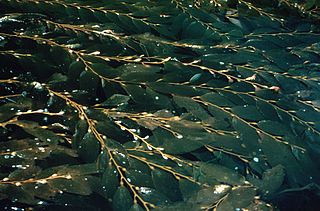
Macrocystis is a monospecific genus of kelp with all species now synonymous with Macrocystis pyrifera. It is commonly known as giant kelp or bladder kelp. This genus contains the largest of all the Phaeophyceae or brown algae. Macrocystis has pneumatocysts at the base of its blades. Sporophytes are perennial and the individual may live for up to three years; stipes/fronds within a whole individual undergo senescence, where each frond may persist for approximately 100 days. The genus is found widely in subtropical, temperate, and sub-Antarctic oceans of the Southern Hemisphere and in the northeast Pacific. Macrocystis is often a major component of temperate kelp forests.
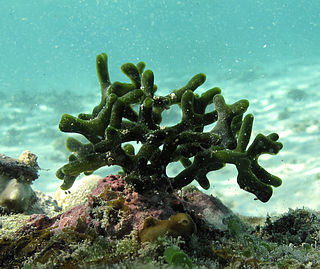
Codium is a genus of edible green macroalgae under the order Bryopsidales. The genus name is derived from a Greek word that pertains to the soft texture of its thallus. One of the foremost experts on Codium taxonomy was Paul Claude Silva at the University of California, Berkeley. Silva was able to describe 36 species for the genus, and in honor of his work on Codium, the species C. silvae was named after the late professor.

Lessonia is a genus of large kelp native to the southern Pacific Ocean. It is the only kelp to be restricted to the southern hemisphere and is primarily distributed along the coasts of South America, New Zealand, Tasmania, and the Antarctic islands. Lessonia is one of two principal genera in kelp forests.

The genus Umbraulva, which is a green alga within the Ulvaceae family, was proposed by Bae and Lee in 2001. Three additional species, including U. kuaweuweu, which was subsequently transferred to another genus, have been added to the genus since it originally had the three species that were initially examined to form the genus. Umbraulva species grow upon hard substrates, and inhabit deep subtidal areas. Species within this genus are widely distributed, and have been identified in Asia, Europe, Hawaii, and New Zealand. The morphological traits of Umbraulva vary among species, but commonly, Umbraulva are macroscopic with olive green blades containing the photosynthetic pigment siphonaxanthin. The blades are flattened and ellipsoid in shape, or are narrow and oval shaped, with perforations and/or lobes present throughout the blade. As Umbraulva often appear very similar in morphology to closely related groups, the main manner in which Umbraulva was differentiated from related groups was through the divergence of ITS and partial SSU rDNA sequences from those of other Ulva species. Umbraulva is closely related to Ulva, which due to wide distributions, high carbohydrate levels, and a lack of lignin, is a good candidate for use in biofuel, bioremediation, carbon sequestration, and animal feed production.

Ulva intestinalis is a green alga in the family Ulvaceae, known by the common names sea lettuce, green bait weed, gutweed, and grass kelp. Until they were reclassified by genetic work completed in the early 2000s, the tubular members of the sea lettuce genus Ulva were placed in the genus Enteromorpha.
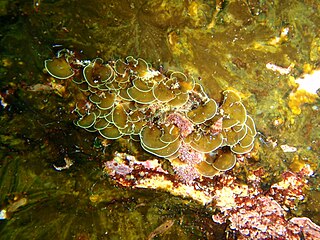
Zonaria is a genus of brown alga.The thallus is often between 5 and 27 centimeters tall and only 6-12 cell layers thick.

Bangiales is an order of multicellular red algae of the class Bangiophyceae containing the families Bangiaceae, Granufilaceae, and possibly the extinct genus Rafatazmia with one species, Rafatazmia chitrakootensis. They are one of the oldest eukaryotic organisms, possibly dating back to 1.6 billion years old. Many species are used today as food in different cultures worldwide. Their sizes range from microscopic (Bangiomorpha) to up to two meters long. Many of its species are affected by Pythium porphyrae, a parasitic oomycete. Similar to many other species of red algae, they reproduce both asexually and sexually. They can be both filamentous or foliose, and are found worldwide.
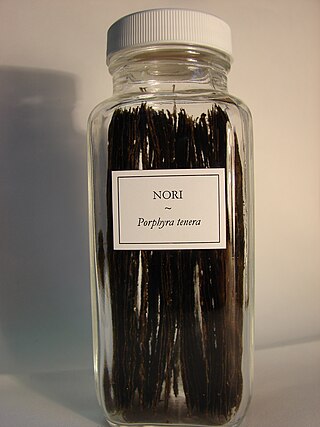
Pyropia tenera, also known as gim or nori, is a red algal species in the genus Pyropia. The specific name, tenera, means "delicate" and alludes to its small size. It typically grows to lengths between 20 and 50 cm. It is most typically found in the western Pacific Ocean and the Indian Ocean.
Porphyra cinnamomea is a red alga species in the genus Porphyra, known from New Zealand. It is monostromatic, monoecious, and grows in the intertidal zone, predominantly on rock substrata. With P. coleana, P. rakiura and P. virididentata, they can be distinguished by morphology, as well as geographical, ecological and seasonal distribution patterns, and importantly, chromosome numbers, which in this species n = 3. Finally, these four species are distinguished by a particular nucleotide sequence at the 18S rDNA locus.
Pyropia rakiura, formerly known as Porphyra rakiura, is a red alga species in the genus Pyropia, known from New Zealand. It is monostromatic, monoecious, and grows in the intertidal zone, predominantly on rock substrata. With P. cinnamomea, P. coleana and P. virididentata, they can be distinguished by morphology, as well as geographical, ecological and seasonal distribution patterns, and importantly, chromosome numbers, which in this species n = 2. Finally, these four species are distinguished by a particular nucleotide sequence at the 18S rDNA locus.
Pyropia virididentata, formerly known as Porphyra virididentata, is a red alga species in the genus Pyropia. It is endemic to New Zealand. It is monostromatic, monoecious, and grows in the intertidal zone, predominantly on rock substrata. With Porphyra cinnamomea, Pyropia rakiura and Clymene coleana, they can be distinguished by morphology, as well as geographical, ecological and seasonal distribution patterns, and importantly, chromosome numbers, which in this species n = 3. Finally, these four species are distinguished by a particular nucleotide sequence at the 18S rDNA locus.
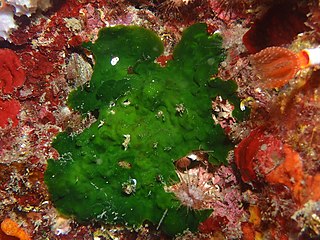
Palmophyllum crassum is a species of algae. It has a cosmopolitan distribution in deep seawater habitats.
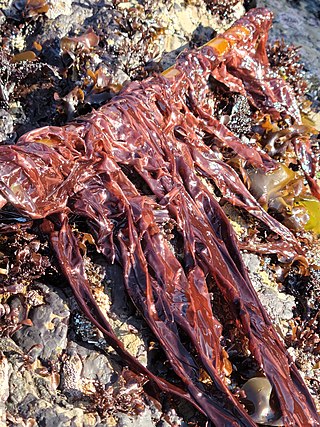
Pyropia is a genus of red algae in the family Bangiaceae. It is found around the world in intertidal zones and shallow water. The genus has folding frond-like blades which are either red, brown or green. Some Pyropia species are used to create nori, and are thus important subjects for aquaculture.

Gonactinia is a monotypic genus of sea anemones, and G. prolifera is the only species in the genus. It is sometimes called the storey anemone and is found on either side of the northern Atlantic Ocean.

Wendy Alison Nelson is a New Zealand marine scientist and world expert in phycology. She is New Zealand's leading authority on seaweeds. Nelson is particularly interested in the biosystematics of seaweeds/macroalgae of New Zealand, with research on floristics, evolution and phylogeny, as well as ecology, and life history studies of marine algae. Recently she has worked on the systematics and biology of red algae including coralline algae, distribution and diversity of seaweeds in harbours and soft sediment habitats, and seaweeds of the Ross Sea and Balleny Islands.
Pythium porphyrae, is a parasitic species of oomycete in the family Pythiaceae. It is the cause of red rot disease or red wasting disease, also called akagusare (赤ぐされ) in Japanese. The specific epithet porphyrae (πορφυρα) stems from the genus of one of its common hosts, Porphyra, and the purple-red color of the lesions on the thallus of the host. However, many of its hosts have been moved from the genus Porphyra to Pyropia.
Crustaphytum is a genus of red alga first discovered in Taoyuan algal reefs by Taiwanese scientists. The epithet “crusta” refers to crustose thallus and “phytum” refers to plant. Belonging to the family Hapalidiaceae in the order Hapalidiales, Crustaphytum is one kind of crustose coralline algae.
Rosenvingea is a genus of brown algae first described by Frederik Børgesen in 1914.

Peyssonneliales is a monotypic order of red algae belonging to the class Florideophyceae and the subclass Rhodymeniophycidae. It contains only 1 known family, PeyssonneliaceaeDenizot, M., 1968.
Palmophyllum umbracola is a species of algae. It is found in New Zealand waters particularly the Kermadec and Three Kings Islands, the northeastern part of the North Island of New Zealand, and the West coast of North America.













